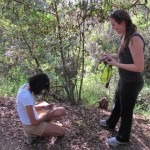When I learned to fold a paper crane out of a piece of paper, I thought I had mastered one of the coolest tricks ever. The crane was the most difficult pattern in my little origami book. But origami is more than paper birds, cups and frogs. It is an art form and a way to gain insights in engineering and math.

Art gallery-goers make origami boxes and cups for jelly beans at the opening of an origami exhibit at UC Santa Cruz. Photo by Marissa Fessenden
Origami is a traditionally Japanese art. Purists follow simple rules: one square of paper, no cuts and no glue. By folding the paper into mountains and valleys in sequence, artists shape designs. Some are incredibly complex.
Traditionally, finding new origami forms relied on trial, error and some luck. But computers have opened up a new way to develop designs. Robert Lang, a physicist and mathematical origami artist, has even created a program that can spit out the pattern of folds necessary to make any shape—a reindeer, a beetle, a scorpion. He likes insects because their many skinny appendages posed a challenge to origami artists of yore.
Least you scoff at the simplicity of Lang’s approach, or accuse him of taking talent away from the art, realize that the pattern still requires a master folder. Lang also tweaks the patterns to make the end result more pleasing and natural looking. Check out his gallery here. This hermit crab is one of my favorites.
(video by Wired)
Math and origami go even beyond the development of new designs. Computational origami is actually a field of mathematics where paper folding can solve problems. For example, a puzzle for geometry is to draw an angle that is exactly one-third of a given, arbitrary angle using only a straightedge and a compass. This exercise is impossible, but becomes possible when you can fold the paper.
Lang is also a master of using origami for real world applications. He helped design the optimal folding of an airbag for cars and consulted for the Lawrence Livermore National Laboratory to develop a telescope lens that would unfold to the size of a football field once it reached space.
When he meets with a client who wants to use origami he asks if cutting is a problem. The restriction to stick to uncut paper is merely artistic. In many cases, cutting provides a better solution for practical application.
Another great example of the uses of origami is a folding, implantable medical device, known as a stent, developed by Zhong You and Kaori Kuribayashi from Oxford. Stents are tubular structures used to hold open a part of the body such as a weakened blood vessel, and restore fluid flow. You and Kuribayashi used origami to make tubular stents that fold to a small diameter while they are delivered to the right location. Once in place, the stents can expand. Traditional stents are made of wire mesh. The origami stents can be made of other, more bio-compatible materials.
I listened to Lang talk at a recent UC Santa Cruz lecture on mathematics and origami. The talk marked the opening of an exhibit honoring the late David Huffmann, a computer scientist and renowned origami artist. If you are in town and would like to visit the exhibit, stop by the Eloise Pickard Smith Gallery at Cowell College. Pieces by David Huffmann, Erik Demaine and his father Martin Demaine, Robert Lang, Brian Chan and Eric Joisel will be displayed through June 16.
And those wishing to master the art of folding paper cranes can learn here.







Comments are closed.